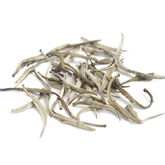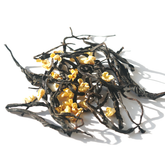Is Oolong Tea Black Tea? A Guide to Fermentation, Taste, and Brewing Differences
Oolong tea is not black tea. They are two completely different types of tea. While both oolong and black tea come from the same tea plant, they differ significantly in fermentation level, taste, and brewing methods. Many people often mistake oolong tea for black tea, mainly because both teas have a rich flavor and complex aroma, and sometimes their dry leaf appearance is quite similar.The color of lightly fragrant oolong tea is usually dark green, which is easy to identify. On the other hand, roasted oolong tea can sometimes have a color very similar to black tea, presenting a reddish-brown color, so tasting is a more accurate way to differentiate them. In fact, oolong tea is a semi-fermented tea that lies between green tea and black tea, with its signature feature being its high aroma. The unique fermentation process gives it the fresh fragrance of green tea, while also retaining the strong, bold flavor of black tea. As the head of a tea supply chain in China with years of experience, I have compiled this article to explain in detail the differences between oolong and black tea. This article will cover the history, varieties, brewing methods, and health benefits of oolong tea, helping tea enthusiasts better understand the distinctions between oolong and black tea.
In fact, oolong tea is a semi-fermented tea that lies between green tea and black tea, with its signature feature being its high aroma. The unique fermentation process gives it the fresh fragrance of green tea, while also retaining the strong, bold flavor of black tea. As the head of a tea supply chain in China with years of experience, I have compiled this article to explain in detail the differences between oolong and black tea. This article will cover the history, varieties, brewing methods, and health benefits of oolong tea, helping tea enthusiasts better understand the distinctions between oolong and black tea.
Oolong Tea vs.Black Tea: Key Differences
| Category | Black Tea | Oolong Tea |
| Oxidation Level | Fully oxidized (80%-95%) | Partially oxidized (10%-70%) |
| Processing | Withering → Rolling → Oxidation → Drying | Withering → Shaking/Tumbling → Pan-firing → Rolling → Roasting |
| Color | Bright reddish-amber | Golden to amber (varies with oxidation level) |
| Flavor | Rich & sweet with honey/caramel notes | Fresh & floral with fruity/roasted notes |
| Main Regions |
China: Fujian (Lapsang Souchong), Yunnan (Dian Hong) India, Sri Lanka |
China: Fujian (Tieguanyin, Da Hong Pao), Guangdong (Fenghuang Dancong), Taiwan (Dong Ding) |
| Brewing Temp | 185–195°F (85–90°C) – Avoid high heat to preserve sweetness | 200–212°F (95–100°C) – High heat releases aromatic oils |
| Popular Types | Lapsang Souchong, Keemun, Yunnan Black | Tieguanyin, Da Hong Pao, Milk Oolong, Phoenix Dancong |
Common Oolong Tea Varieties
The main production areas of oolong tea include Fujian Province, Guangdong Province, and Taiwan in China. Fujian is the birthplace of oolong tea, with famous regions like Wuyi Mountain, which produces the renowned Da Hong Pao, and Anxi, known for its Tie Guan Yin. Oolong tea from Taiwan is known for its fresh taste due to its high-altitude climate, with famous areas like Dong Ding Mountain and Ali Mountain, producing highly regarded Dong Ding oolong and high-mountain oolong teas. Guangdong Province’s Fenghuang Dancong is also well-known for its rich floral and fruity aroma. These oolong teas from different regions are characterized by unique flavors due to their distinct climate and soil conditions, offering a rich variety of tastes. Below are some common oolong tea varieties from China and their flavor profiles.
These oolong teas from different regions are characterized by unique flavors due to their distinct climate and soil conditions, offering a rich variety of tastes. Below are some common oolong tea varieties from China and their flavor profiles.
| Name | Origin | Key Features | Flavor Notes |
| Tieguanyin | Anxi, Fujian | Light to medium fermentation. Rolled into tight balls. | Orchid aroma, creamy texture, sweet aftertaste. |
|
Da Hong Pao (Big Red Robe) |
Wuyi Mountain,Fujian | Heavy roasting, "rock tea" (grown on cliffs). Rare and expensive. | Smoky, mineral, with caramelized fruit notes. |
| Shui Xian (Narcissus) | Wuyi Mountain,Fujian | Medium fermentation. Aged varieties develop deeper flavors. | Woody, roasted nuts, honey undertones. |
| Fenghuang Dancong | Phoenix Mountain,GuangDong | Single-bush harvesting. Over 10 aroma types (e.g., honey, almond, osmanthus). | Intense floral, fruity, or nutty depending on type. |
| Dong Ding | Nantou County,Taiwan | Medium roasting. Tightly rolled leaves. | Toasty, buttery, with magnolia fragrance. |
| Oriental Beauty | Hsinchu County,Taiwan | Bug-bitten leaves (natural oxidation). No roasting. | Honey, ripe fruit, and cinnamon spice. |
Comparison of Fermentation

| Aspect | Black Tea | Oolong Tea |
| Fermentation | Full oxidation (90-100%) | Partial oxidation (10-85%) |
| Flavor | Rich, malty, or fruity | Ranges from floral/fresh to toasty/roasty |
| Appearance | Dark leaves, red-brown liquor | Green to dark brown leaves, amber liquor |
Oolong Tea Brewing Guide
Oolong tea requires quick infusion to avoid prolonged steeping, and it is recommended to use a gaiwan. By controlling the water temperature and steeping time, you can fully release its high fragrance and layered flavor. Lightly fermented oolong tea can be steeped for a longer time, while heavily roasted oolong tea should not be steeped for too long. Boiling water is necessary to better release the aroma of oolong tea.
| Category | Recommendations | Tips |
| Teaware | Gaiwan | Use a tea set gaiwan for high-aroma oolongs (e.g., Tieguanyin) to control steeping time. |
| Tea-to-Water Ratio | 1:20 (e.g., 6g tea per 120ml water) |
• Fill 1/3-1/4 of the teaware with tightly rolled tea (e.g., Tieguanyin). • Use slightly more tea for loose-leaf styles (e.g., Yancha). |
| Water Temperature | 100°C boiling water |
Boiling water maximizes aroma and flavor. • Preheat teaware to avoid temperature drop. |
| Steeping Time |
Light-fermented (e.g., floral oolongs): 40s first infusion, +15s each round. Heavy-fermented (e.g., Da Hong Pao): 15s first infusion, +10s each round. |
• Quick pours for first 3 infusions prevent bitterness. • Extend time after the 4th infusion. • High-quality oolongs can steep 7+ times. |
SEE MORE CHINESE TEAS
If you have questions about selecting tea:
Learn-more-about-chinese-tea
If you have questions about the benefits of tea:
Health-benefits-of-chinese-tea
If you have questions about brewing tea:
How-to-brew-loose-leaf-tea






